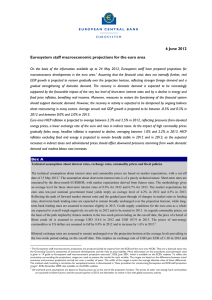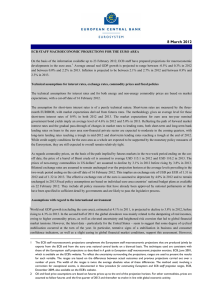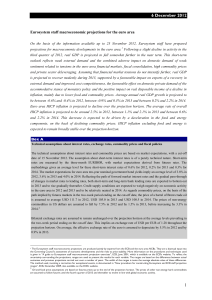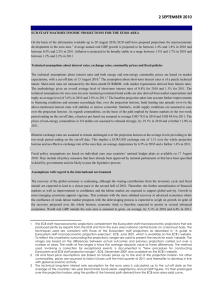2 December 2010 Eurosystem staff macroeconomic projections for the euro area
advertisement
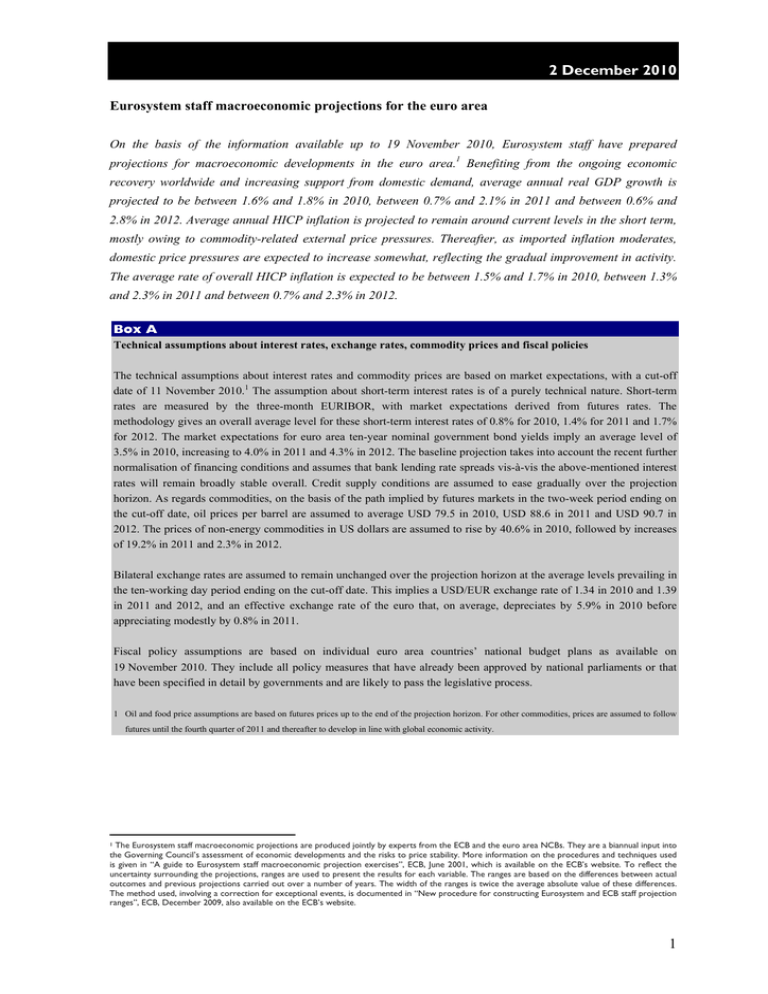
2 December 2010 Eurosystem staff macroeconomic projections for the euro area On the basis of the information available up to 19 November 2010, Eurosystem staff have prepared projections for macroeconomic developments in the euro area.1 Benefiting from the ongoing economic recovery worldwide and increasing support from domestic demand, average annual real GDP growth is projected to be between 1.6% and 1.8% in 2010, between 0.7% and 2.1% in 2011 and between 0.6% and 2.8% in 2012. Average annual HICP inflation is projected to remain around current levels in the short term, mostly owing to commodity-related external price pressures. Thereafter, as imported inflation moderates, domestic price pressures are expected to increase somewhat, reflecting the gradual improvement in activity. The average rate of overall HICP inflation is expected to be between 1.5% and 1.7% in 2010, between 1.3% and 2.3% in 2011 and between 0.7% and 2.3% in 2012. Box A Technical assumptions about interest rates, exchange rates, commodity prices and fiscal policies The technical assumptions about interest rates and commodity prices are based on market expectations, with a cut-off date of 11 November 2010.1 The assumption about short-term interest rates is of a purely technical nature. Short-term rates are measured by the three-month EURIBOR, with market expectations derived from futures rates. The methodology gives an overall average level for these short-term interest rates of 0.8% for 2010, 1.4% for 2011 and 1.7% for 2012. The market expectations for euro area ten-year nominal government bond yields imply an average level of 3.5% in 2010, increasing to 4.0% in 2011 and 4.3% in 2012. The baseline projection takes into account the recent further normalisation of financing conditions and assumes that bank lending rate spreads vis-à-vis the above-mentioned interest rates will remain broadly stable overall. Credit supply conditions are assumed to ease gradually over the projection horizon. As regards commodities, on the basis of the path implied by futures markets in the two-week period ending on the cut-off date, oil prices per barrel are assumed to average USD 79.5 in 2010, USD 88.6 in 2011 and USD 90.7 in 2012. The prices of non-energy commodities in US dollars are assumed to rise by 40.6% in 2010, followed by increases of 19.2% in 2011 and 2.3% in 2012. Bilateral exchange rates are assumed to remain unchanged over the projection horizon at the average levels prevailing in the ten-working day period ending on the cut-off date. This implies a USD/EUR exchange rate of 1.34 in 2010 and 1.39 in 2011 and 2012, and an effective exchange rate of the euro that, on average, depreciates by 5.9% in 2010 before appreciating modestly by 0.8% in 2011. Fiscal policy assumptions are based on individual euro area countries’ national budget plans as available on 19 November 2010. They include all policy measures that have already been approved by national parliaments or that have been specified in detail by governments and are likely to pass the legislative process. 1 Oil and food price assumptions are based on futures prices up to the end of the projection horizon. For other commodities, prices are assumed to follow futures until the fourth quarter of 2011 and thereafter to develop in line with global economic activity. The Eurosystem staff macroeconomic projections are produced jointly by experts from the ECB and the euro area NCBs. They are a biannual input into the Governing Council’s assessment of economic developments and the risks to price stability. More information on the procedures and techniques used is given in “A guide to Eurosystem staff macroeconomic projection exercises”, ECB, June 2001, which is available on the ECB’s website. To reflect the uncertainty surrounding the projections, ranges are used to present the results for each variable. The ranges are based on the differences between actual outcomes and previous projections carried out over a number of years. The width of the ranges is twice the average absolute value of these differences. The method used, involving a correction for exceptional events, is documented in “New procedure for constructing Eurosystem and ECB staff projection ranges”, ECB, December 2009, also available on the ECB’s website. 1 1 2 December 2010 The international environment The global recovery is ongoing but decelerating temporarily, as the previously supportive contributions from inventories and the fiscal stimulus packages are coming to an end. Looking ahead, global economic growth is expected to strengthen gradually over the projection horizon, supported by progress in balance sheet repair and an improvement of financing conditions. Dynamic emerging markets remain the main driver of global economic growth over the projection horizon. At the same time, in major advanced economies labour markets are projected to remain weak, holding back growth. Overall, global growth is projected to remain relatively subdued compared with most previous post-recession recoveries. World real GDP outside the euro area is projected to increase by 5.3% in 2010, by 4.3% in 2011 and by 4.7% in 2012. Growth in the euro area’s export markets is estimated to be 11.3% in 2010, 7.2% in 2011 and 7.2% in 2012. Real GDP growth projections Following strong growth in the second quarter of 2010, real GDP grew by 0.4% in the third quarter. Available information suggests net exports contributed to growth, while domestic demand also increased, albeit at more subdued rates than in the previous quarter. In the last quarter of 2010, growth is expected to remain weaker than during the first half of the year, as the supportive impact of fiscal stimuli, the inventory cycle and the rebound in trade is diminishing. Looking ahead, economic activity is projected to continue its recovery, led by exports, with domestic demand gradually gathering pace. This rebalancing of activity reflects the effects of accommodative monetary policy and the significant efforts made to restore the functioning of the financial system. However, in line with patterns observed following past banking crises, the economic recovery is projected to be muted. The need for balance sheet repair in various sectors is dampening the growth outlook for the euro area. In annual terms, real GDP growth is expected to be between 1.6% and 1.8% in 2010, between 0.7% and 2.1% in 2011 and between 0.6% and 2.8% in 2012. In more detail, among the domestic components of GDP, private consumption growth is expected to rise modestly in 2010 and to firm gradually over the projection horizon. As employment developments continue to improve, related incomes are expected to increase. In addition, the household saving ratio is projected to decline as confidence improves in line with labour market developments and lower uncertainty. Reflecting the gradual improvement in economic activity and employment, the unemployment rate is expected first to stabilise, before declining in 2012. Non-residential private investment is expected to continue to recover slowly as spare capacity gradually diminishes, demand prospects firm, financing constraints loosen and uncertainty recedes. Residential investment, while picking up slightly, is projected to remain subdued, still dampened by ongoing adjustments in housing markets in some countries. In line with the fiscal consolidation packages announced in several euro area countries, government investment in real terms is assumed to be weak over the projection horizon. 2 2 December 2010 Table 1 Macroeconomic projections for the euro area (average annual percentage changes)1), 2) 2009 2010 2011 2012 HICP 0.3 1.5 – 1.7 1.3 – 2.3 0.7 – 2.3 Real GDP -4.1 1.6 – 1.8 0.7 – 2.1 0.6 – 2.8 -1.1 0.6 – 0.8 0.4 – 1.4 0.5 – 2.3 Private consumption Government consumption 2.4 0.5 – 1.3 -0.8 – 0.6 -0.4 – 1.0 Gross fixed capital formation -11.3 -1.4 – -0.6 -0.5 – 3.1 0.1 – 5.3 Exports (goods and services) -13.1 9.9 – 11.7 3.7 – 8.7 2.5 – 8.7 Imports (goods and services) -11.8 8.2 – 9.8 2.6 – 7.6 2.3 – 8.1 1) The projections for real GDP and its components refer to working day-adjusted data. The projections for imports and exports include intra-euro area trade. 2) Estonia is included in the euro area projections for 2011. The average annual percentage changes for 2011 are based on a euro area composition in 2010 that already includes Estonia. Following a strong rebound during the first three quarters of 2010, exports are expected to continue to grow, albeit at a somewhat slower pace, driven by foreign demand over the whole projection horizon and greater price competitiveness early on. The growth of imports is also expected to slow somewhat over the period 2011-12 from the high levels seen in 2010. Overall, net trade is projected to make a positive, but diminishing, contribution to GDP growth. Largely reflecting the impact of the crisis, potential growth is expected to recover somewhat, albeit to moderate levels, over the projection horizon. This modest outlook results from a rise in structural unemployment, lower labour force participation rates and the weakness of investment. The magnitude of these effects, however, is very uncertain and projections of potential growth, and accordingly of the output gap, are surrounded by an even higher degree of uncertainty than usual. This notwithstanding, the estimated output gap is expected to narrow over the projection horizon. Price and cost projections Owing mainly to oil and food price rises, overall HICP inflation is projected to stay close to 2% until early 2011. Thereafter, while imported inflation moderates, domestic price pressures are expected to increase somewhat, reflecting the gradual improvement in activity. The average rate of overall HICP inflation is expected to be between 1.5% and 1.7% in 2010, between 1.3% and 2.3% in 2011 and between 0.7% and 2.3% in 2012. The growth rate of the HICP excluding food and energy is projected to increase gradually over the entire projection horizon, reflecting the slowly increasing growth of unit labour costs in the context of improving labour market conditions. In more detail, after a strong increase in 2010, driven by the rebound in commodity prices and the past depreciation of the euro, external price pressures are projected to diminish over the projection horizon. Turning to domestic pressures, growth in compensation per hour in the euro area is projected to be 3 2 December 2010 modest in 2010. Thereafter, in line with the improvement in the labour market, stronger increases are expected. This holds for both the public and private sectors, albeit to a lesser extent in the case of the public sector, reflecting fiscal consolidation and the fact that public sector wages tended to be slower to adjust to the economic downturn. Taking into account the strong cyclical recovery in labour productivity, the projected profile of wages implies a substantial decline in the growth of unit labour costs in 2010. Thereafter, once productivity gains have stabilised and wages rebound further, unit labour costs are expected to grow moderately. Profit margins are projected to continue to widen over the projection horizon, having fallen steeply during the recession. On the basis of measures already announced, indirect taxes are also assumed to make a small positive contribution to HICP inflation over the projection horizon. Comparison with the September 2010 projections With regard to real GDP growth, the projection range for 2010 has narrowed somewhat and shifted towards the upper end of the range published in the September 2010 issue of the Monthly Bulletin. The range for 2011 is slightly narrower compared with that published in September. With regard to HICP inflation, the projection range for 2010 is unchanged, while the range for 2011 is marginally higher than in the previous projection. Table 2 Comparison with the September 2010 projections (average annual percentage changes) 2010 2011 Real GDP – September 2010 1.4 – 1.8 0.5 – 2.3 Real GDP – December 2010 1.6 – 1.8 0.7 – 2.1 HICP – September 2010 1.5 – 1.7 1.2 – 2.2 HICP – December 2010 1.5 – 1.7 1.3 – 2.3 Box B Forecasts by other institutions A number of forecasts for the euro area are available from both international organisations and private sector institutions. However, these forecasts are not strictly comparable with one another or with the Eurosystem staff macroeconomic projections, as they were finalised at different points in time. Additionally, they use different (partly unspecified) methods to derive assumptions for fiscal, financial and external variables, including oil and other commodity prices. Finally, there are differences in working day adjustment methods across different forecasts (see the table below). In the forecasts currently available from other institutions, euro area real GDP is expected to grow by between 1.6% and 1.7% in 2010, between 1.4% and 1.7% in 2011 and between 1.6% and 2.0% in 2012. All these forecasts fall within the ranges of the Eurosystem staff projections. As regards inflation, the forecasts from other institutions anticipate average annual HICP inflation to be between 1.5% and 1.6% in 2010, between 1.3 and 1.8% in 2011 and between 1.2% and 1.7% in 2012. These forecasts for inflation are also in line with the ranges of the Eurosystem staff projections. 4 2 December 2010 Comparison of forecasts for euro area real GDP growth and HICP inflation (average annual percentage changes) Date of release GDP growth HICP inflation 2010 2011 2012 2010 2011 2012 IMF Survey of Professional Forecasters October 2010 October 2010 1.7 1.6 1.5 1.5 1.8 1.7 1.6 1.5 1.5 1.5 1.5 1.6 Consensus Economics Forecasts November 2010 1.6 1.4 1.6 1.5 1.6 1.5 OECD November 2010 1.7 1.7 2.0 1.5 1.3 1.2 European Commission November 2010 1.7 1.5 1.8 1.5 1.8 1.7 Eurosystem staff projections December 2010 1.6 – 1.8 0.7 – 2.1 0.6 – 2.8 1.5 – 1.7 1.3 – 2.3 0.7 – 2.3 Sources: European Commission Economic Forecasts, Autumn 2010; IMF World Economic Outlook, October 2010; OECD Economic Outlook, November 2010; Consensus Economics Forecasts; and the ECB’s Survey of Professional Forecasters. Notes: The Eurosystem staff macroeconomic projections and the OECD forecasts both report working day-adjusted annual growth rates, whereas the European Commission and the IMF report annual growth rates that are not adjusted for the number of working days per annum. Other forecasts do not specify whether they report working day-adjusted or nonworking day-adjusted data. 5
